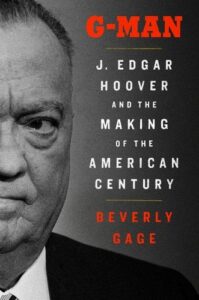
How Hollywood Made J. Edgar Hoover and the FBI Into the Mythical “G-Men”
On the PR Campaign That Changed the Modern FBI
The display case outside J. Edgar Hoover’s office was not necessarily what President Roosevelt had in mind when he called upon law enforcement to “interpret” the problem of crime. But it was a start, a hint that Hoover was taking notice of the public interest in crime narratives and adjusting his self-presentation accordingly. Another clue came when Hoover began to push for a new name to replace the “Division of Investigation.” Since the end of Prohibition, he had longed to break away from what remained of the Prohibition Bureau—technically a separate entity, but still under the roof of his division. He had also advocated for a renaming, pointing out that other government agencies maintained their own “divisions” of investigation, a source of frequent confusion.
In March 1935, just after completing the move into his new office, he got his wish. For all its later significance, the adoption of the name Federal Bureau of Investigation—FBI—occurred with little fanfare. Many other bureaus went through similar shifts during the 1930s, losing an initial here, gaining another there. As a reconfigured “alphabet agency,” the FBI was little different from the Civilian Conservation Corps (CCC), Works Progress Administration (WPA), or Securities and Exchange Commission (SEC), three-letter agencies born of early New Deal planning.
Still, the name meant a great deal to Hoover and his inner circle, who had toiled for more than a decade to prove themselves different from the tainted Bureau of the past. To them, the name “FBI” provided a long-desired opportunity to draw a line with the past and redefine itself for the dawning age of government public relations. “Those initials also represent the three things for which the Bureau and its representatives always stand: ‘Fidelity-Bravery-Integrity,’” an inspector declared in the Bureau’s in- house magazine.
The press liked the change. “It’s F.B.I. Now,” declared one of Hoover’s favorite reporters, labeling the three-initial formula a “godsend to headline writers.” A new name and a new office only went so far, however. Roosevelt’s larger questions remained: How would the FBI interpret the issue of crime? To come up with an answer, Hoover turned not to Henry Suydam, the Justice Department’s press agent, but to Courtney Ryley Cooper, the circus man turned news reporter who had worked so closely with Hoover in the early 1930s.
In the fall of 1934, just before the crime conference, Cooper had proposed to Hoover that they collaborate on a book: Cooper would write the text and Hoover would write the foreword. Together, they would produce just what the moment called for: a “crime book” that “book-sellers all over America . . . can get behind and push to the limit.”
Coming from anyone else, the offer would certainly have been rejected. Since it came from Cooper, Hoover took a chance and said yes. In contrast to press conferences, where he offered statements and reporters wrote whatever they wanted, the book provided an opportunity for him to put his own stamp on the crime-war narrative, to go on record about what had happened and why. Cooper agreed to abide by Hoover’s suggestions and allowed him to approve the book’s title, Ten Thousand Public Enemies. In return, Hoover furnished Cooper with Bureau files and case summaries, and designated agents to fact-check the book. Suydam warned that opening up Bureau materials might anger other reporters, and “might lead the readers to believe that the Department had not used much discretion in the matter.” Hoover ignored these instructions and treated Cooper as a special confidant.
According to Motion Picture Daily, Hoover ordered his agents to stay away from all preview showings and “to refuse any statements whatsoever regarding them.”
Cooper found Hoover’s attention to be a mixed blessing. While he depended upon Hoover for access and gravitas, he also expressed frustration at the Bureau’s painstaking attention to detail and at Hoover’s hesitation about engaging the true drama of what had taken place over the past few years. As the weeks went on and the publication date neared, Cooper was forced to remind his Bureau friends that “time is getting a little short in setting this stuff up and making corrections.” Agents nonetheless continued to churn out fact-checking memos, fixing dates, name spellings, phrasings, and technicalities of criminal law. In mid-January, Hoover balked when an agent noted that Cooper’s writing contained “considerable criticism, directly and by innuendo, of local police departments as well as of the Bureau of Prisons.” Despite Cooper’s impatience, Hoover ordered another vetting of the book.
When the book finally emerged, reviewers had no trouble identifying it “as a mouthpiece of the director of that interesting bureau, John Edgar Hoover,” in the words of The Washington Post. As Hoover’s first effort to live up to Roosevelt’s dictum, Ten Thousand Public Enemies attempted to combine scientific management and whitecollar integrity with gangsters and guns. The result encompassed an odd range of attributes, in which Hoover came across both as a “friendly, businesslike” sort of fellow and as the righteous scourge of “‘sob sisters,’ ‘morons’ and ‘smug citizens’ who . . . either do nothing to prevent crime or display an active sympathy for the criminal.”
The title promised more than the book delivered. “Ten thousand public enemies” referred to the hard core of violent criminals who had necessitated the federal government’s turn to “machine guns, automatic rifles and perhaps tear-gas guns in order to be properly armed.” And yet the book itself took some two hundred pages to arrive at the Kansas City Massacre and another hundred before plunging into the Dillinger case—leaving fewer than sixty pages to get through all the really exciting stuff. The bulk of the early chapters focused on Hoover’s transformation of the Bureau. “A vast power . . . slowly has been building, to a great degree in comparative secrecy,” Cooper wrote, “until it now can take its place as a stanchion to strengthen the local law enforcement agencies of the nation.”
To the degree that Cooper engaged specific crimes or actual criminals, he did so by way of illustrating the value of Hoover’s scientific techniques and the importance of national uniformity and coordination. The book served as a rollout for Hoover’s new FBI, fitting the latest headlines into his preferred narrative. Ten Thousand Public Enemies sold tolerably well. But it was the film industry, not the staid world of publishing, that made Hoover into a national legend. In making the transition to the code system, the film studios had granted themselves a brief adjustment period, in which they would be permitted to make violent, graphic crime films—as long as the authorities won.
The result was a gold rush on shoot-outs and bloodshed, as filmmakers tried to cash in on their last few moments of opportunity. “Moviegoers are in for a siege of gunfire . . .” one columnist predicted in the spring of 1935. “But now, the head-line conscious cinema, alert as ever to maintain its standing as a lusty, topical form of theatre, has discovered . . . those cool, efficient and daring public benefactors, the Department of Justice men.”
The siege began with G‑Men, released by Warner Brothers in April 1935, around the same time as the publication of Ten Thousand Public Enemies. Like Hoover’s book, the film featured a heroic corps of detective-lawyers hell-bent on stemming the nation’s violent crime epidemic. Given those similarities, many observers assumed that Hoover had played some role in film’s creation. In truth, G‑Men came about as a Hollywood effort from start to finish: written by commercial screenwriters and produced by a major studio, without either the help or sanction of the FBI. “The Department has approved no motion picture scenario or production purporting to deal with its work,” Cummings said on March 23, just as the film was due to be released. According to Motion Picture Daily, Hoover ordered his agents to stay away from all preview showings and “to refuse any statements whatsoever regarding them.” He made an exception for himself, though, venturing to Baltimore in early May to view one of the first local screenings.
To his surprise, Hoover liked at least some of what he saw. G‑Men starred James Cagney as a scrappy attorney turned federal agent, transferring onto the lawman the same reckless charisma that had been so alluring in The Public Enemy. As its title suggests, the film lavishes attention upon the “Government Men” of the Bureau, and hits upon most of Hoover’s favorite themes: the importance of college-educated agents, the rigor of the Bureau’s firearms training, the scientific revolution within law enforcement, the need to insulate policing from politics.
Characters pause frequently to deliver stock praise for federal crime fighting. “It’s a great department . . . and a great bunch of fellas,” one character says. “When they tackle a job they stick to it ’til they’re finished, with no fat-faced politician standing around telling ’em what to do.” G‑Men put the Bureau’s facilities on-screen for the first time, offering glamour shots of a gym, a bustling lab, and a fingerprint division. A character named Bruce Gregory stands in for Hoover, doling out stern personnel orders and delivering speeches to Congress in favor of greater power for his agents. Faced with the prospect of battling “Gregory’s” men, the film’s leading crime-boss character decides to get out of the rackets, explaining to skeptical underworld confidants that crime would no longer pay now that the “G- Men” had stepped up their game.
This was precisely what the code hoped to accomplish: The agents came across as heroes; the gangsters appeared repentant or incompetent. And yet there was much about the picture that also infuriated Hoover. G‑Men was essentially a gangster picture flipped on its head—“an old type in a new garment,” as one pro-censorship group put it. Far from being one of Hoover’s clean-cut college boys, Cagney’s character Brick Davis grows up as an urban street tough mentored by a Capone-esque boss.
While Hoover prided himself on obedience from subordinates, the rookie Davis is a go-it-alone maverick, always pushing the limits of government rules. Despite his law school education, Davis manages to solve the crime and get the girl only by drawing on insider tips from his underworld contacts. FBI agents had in fact used such methods in the Dillinger case, but Hoover still preferred a brainier, more scientific image. He argued for dispassionate policing, removed from all personal and political considerations; Brick Davis mostly wants to avenge the murder of fellow agents.
By those standards, the real surprise about G‑Men was that Hoover did not react more aggressively against it. He instructed field offices to respond to fan mail with a statement denying both the Bureau’s cooperation and its approval. But in a reversal of his previous stance, he also embraced the film’s title and accepted that he was now a G-Man, fully immersed in American public relations and culture.
___________________________________
Beverly Gage
Beverly Gage is professor of 20th-century American history at Yale. She is the author of The Day Wall Street Exploded, which examined the history of terrorism in the late 19th and early 20th centuries. She writes frequently for the New York Times, the Washington Post, the New York Times Magazine and The New Yorker, among other publications.




















